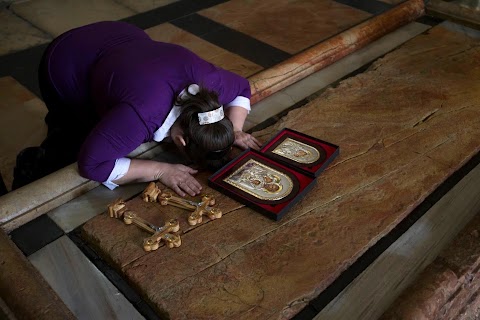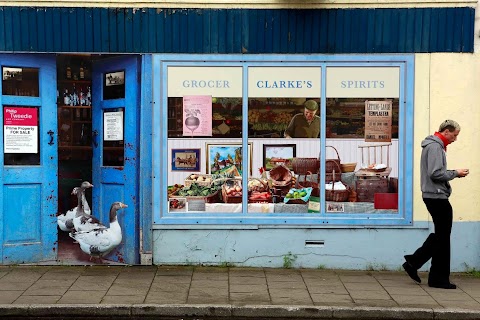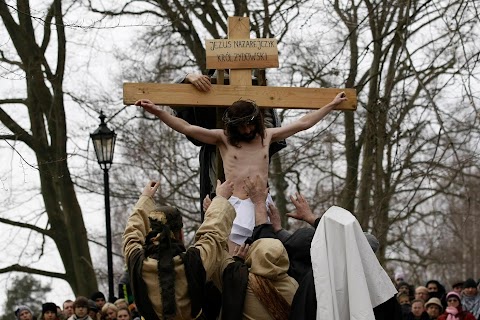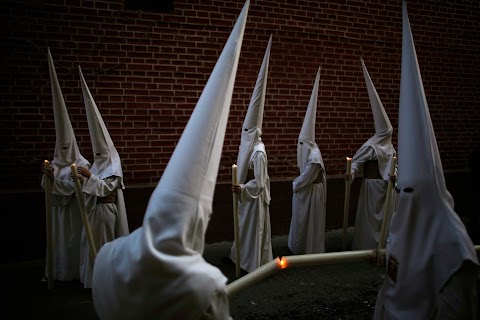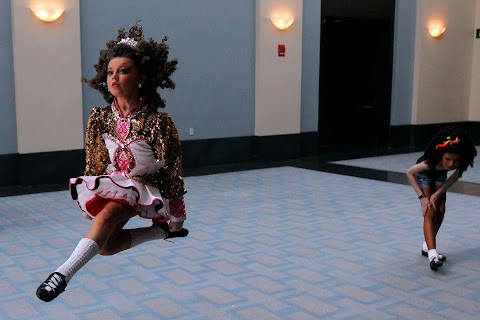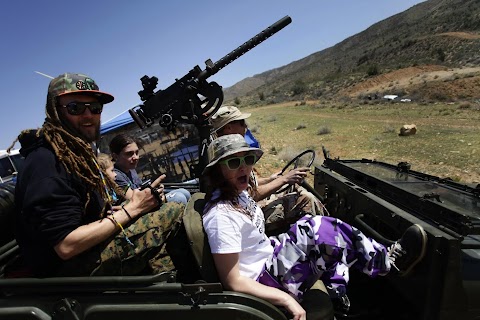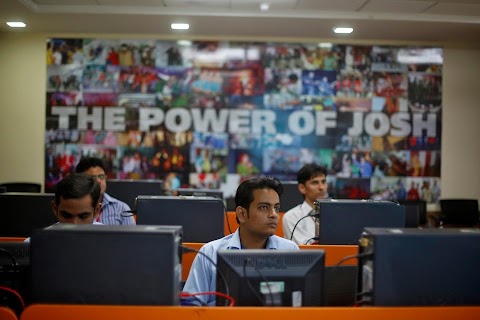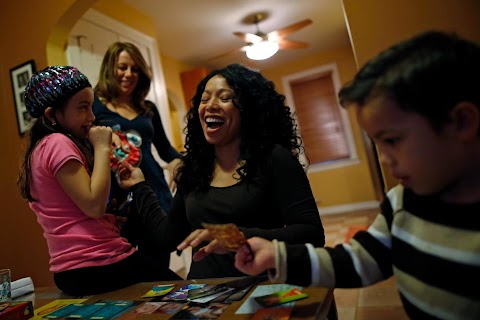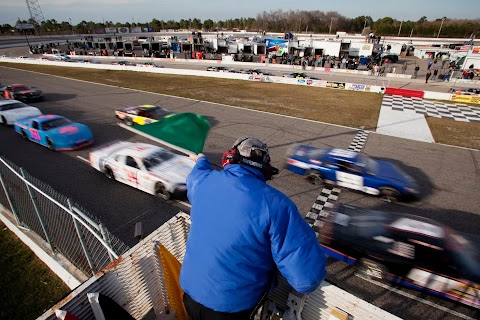
For the love of racing
 Randall Hill
Randall Hill
Official flagman Tim Tolson starts the Southeast Limited, a minor race at the Myrtle Beach Speedway track in South Carolina. Most drivers at the track compete in the Whelen All-American Series of NASCAR - many rungs below the highest level of the sport. The majority have day-jobs and are racing for sheer enjoyment. But paying for their passion is becoming harder, as more sophisticated technology seeps down to the lower levels of NASCAR, driving up the price of maintaining a car.

Justin Miliken is one of the drivers who show complete devotion to the sport, despite having to balance it with a day-job.
“I never see my wife,” he said, “I work all day at my job and then, well, into the evening I’m with the boys in the shop working on the car.”
He has personal experience of the highs and lows of race car driving. Here, he stands misty eyed after crashing on the last lap of his race, missing out on $10,000 in prize money and mangling his team's $40,000 vehicle.

Ben Rhodes, 16, is one of the few drivers racing at Myrtle Beach who might get a chance to move up to the NASCAR Sprint Cup Series - the sport's highest level of competition.
Although he only got his learner’s permit a few weeks ago, he has been racing for two years.
Slideshow

Anthony Anders of Easley, South Carolina, celebrates his win in the Myrtle Beach 400.

Adams Racing crew chief James Clark of McColl, South Carolina, times laps for a driver.

Car 02 driver Justin Miliken temporarily takes the lead in the Myrtle Beach 400. He and his crew led for the majority of the race only to crash on the last lap.

Michael Hardin of Pomfret, Maryland, yells from the seat of his racing car.

Crew member Dale Faircloth relaxes in front of car 88 during a fan meet-and-greet.

Sam Messer, a crew member from Easley, South Carolina, makes adjustments to a wrecked car.

Crew member Jon Strickland (left) and driver Jeremy McDowell of Conway, South Carolina work on their vehicle.

Jerry "Stick" Beck of King William, Virginia, lowers a car from a trailer.

Adams Racing crew member James Clark of Laurinburg, North Carolina, welds the frame of a damaged car.

Race fan Joey Babson and his son Chad watch the action from turn one.

Fans and timers watch the cars whizz past.
"The passion to win was so embedded in them that the loss was personal - like a death wake."
The rippled clouds loomed over the storied infield and pit area of the Myrtle Beach Speedway on the morning of March 22, as drivers and crews scurried to prepare their cars for the races that evening.
Crews dressed in heavy coats and stocking caps pulled tight over their heads made it look like this was an event somewhere in Scandinavia, rather than a springtime good ole boy NASCAR race.
Later, as the sun started to warm the air and the winds subsided, the boys got down to business.
Most drivers and crew in the regional Whelen series of NASCAR race for love of the sport. The majority are plumbers, business owners or shop workers - guys who put in time working on their cars after their long day-jobs have ended. Most have only shallow dreams of making it to the big-time Sprint series of NASCAR.
“I never see my wife,” said Shallotte, North Carolina driver Justin Miliken. “I work all day at my job and then, well, into the evening I’m with the boys in the shop working on the car. But that’s what it takes to be competitive out here.”
Miliken and the others know first-hand about the sacrifices they have to make for love of the sport. He and his crew led the majority of the featured race on March 22, only to crash on the last lap.
Besides the loss of the $10,000 1st place purse, the team’s $40,000 car was heavily damaged and would need extensive repairs. After the race, Miliken and his crew members were shocked. The passion to win was so embedded in them that the loss was personal - like a death wake. Fans and family members surrounded the driver, hugging him and offering support, as he looked into the distance, teary eyed.
Earlier that day, Bobby June, a resident of Hartsville, South Carolina, had a different approach to the sport. Dressed in his blue and pink racing suit with “Tobaccoville USA” stitched across the chest, the 57-year-old driver relaxed beside his #13 car before a limited race.
June funds his need for speed with sponsorship money from a cigarette manufacturing company he owns with his brother. He has been racing in the lower levels of NASCAR since 1978 and has noticed the sport costs a lot more now than it did in the past.
“See that engine there?” June bends over and lightly touches the top of the engine compartment as if it needed special care. “That cost me $25,000 and it blew on the first race we took it on. She owes me one today.”
Tires are another big expense for the crews at Myrtle Beach and in the Whelen Series. A set can run about $800 and must be purchased from the track. Because of the rough racing surface at Myrtle Beach Speedway, it is common for crews to go through two sets of tires during a 250-lap race. That, combined with the price of fuel, means being a “weekend warrior” can be a pricey choice.
Driver Ben Rhoads of Louisville, Kentucky holds himself with confidence outside his #41 race car. According to the other drivers, the 16 year old may be one of the few in the Whelen series that will get a chance at the Sprint Cup series of NASCAR. From the pit areas he watches as crews prepare the car for the race. “I just got my learner’s permit last week so I’m now legal to drive a car in the state of Kentucky,” he says.
Don’t take this fact as evidence that the lanky teenager is inexperienced. He has been racing for two years and has a good sponsorship base behind him. Rhoads may occasionally help push his car or move a tool, but his job is to drive and his crew members are paid professionals.
The white #12 car driven by Asheboro, North Carolina resident Garrett Campbell is in the next pit area down from Rhoads. The sun bounces brightly off the matte surface of the car - not for show but because it lacks paint. With no sponsors, the car is bare of the advertising stickers most other racing vehicles have.
At the fan meet-and-greet before the race, Campbell stood by his car with a grey hoodie pulled over his head. Children and fans flocked to Rhoads' #41 car with autograph requests while he sat there quietly.
Money brings in the fans, and larger purses will bring in sponsored drivers. But most are here for the love of racing.
June said it best after he was asked how the sport had changed over the years: “The only thing that’s changed is it costs more to race and the purse is less.”
